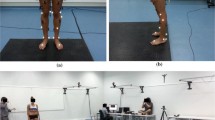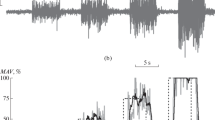Abstract
The use of linear envelopes to represent the electromyographic (EMG) measurements obtained during locomotion has become common practice. Guidelines for designing envelope filters and specifying the minimum number of strides needed to produce valid EMG profiles have been developed. Electromyograms from eight major muscles of the lower leg are measured from five normal young adults during self-selected slow, free and fast walking speeds. 30 strides per task are measured. The ‘ideal’ EMG profile is defined from the ensemble average of the rectified EMG signal. An error measure is defined and used as a criterion to assess the appropriateness of various cut-off frequencies for envelope filters and the number of strides required for establishing a good EMG profile. It is found that between six and ten strides are needed to form a representative profile, and an envelope filter with a minimum cut-off frequency of approximately 9 Hz is necessary.
Similar content being viewed by others
References
Arendt-Nielsen, L. andSinkjaer, T. (1991): ‘Quantification of human dynamic muscle fatigue by electromyography and kinematic profiles,’J. Electromyogr. and Kinesiol.,1, pp. 1–8
Arsenault, A., Winter, D., Marteniuk, R. andHayes, K. (1986): ‘How many strides are required for the analysis of electromyographic data in gait?’Scand. J. Rehab. Med.,18, pp. 133–135
Gottlieb, G. andAgarwal, G. (1971): ‘Dynamic relationship between isometric muscle tension and the electromyogram in man,’J. Appl. Physiol.,30, pp. 345–351
Hamming, R. (1983): ‘Digital filters’ (Prentice Hall, Englewood Cliffs, New Jersey)
Hershler, C. andMilner, M. (1978): ‘An optimality criterion for processing electromyographic (EMG) signals relating to human locomotion,’IEEE Trans.,BME-25, pp. 413–420
Inbar, G., Allin, J. andKranz, H. (1987): ‘Surface EMG spectral changes with muscle length,’Med. Biol. Eng. Comput.,25, pp. 683–689
Kadaba, M., Wooten, M., Gainey andCochran, G. (1985): ‘Repeatability of phasic muscle activity: performance of surface and intramuscular wire electrodes in gait analysis,’J. Orth. Res.,3, pp. 350–359
Kadefors, R. (1973): ‘Myoelectric signal processing as an estimation problem,’ inDesmejt, J. (Ed.): ‘New developments in electromyography and clinical neurophysiology’ (Karger, Basel)
Kleissen, R. (1990): ‘Effects of electromyographic processing methods on comptuer-averaged surface electromyographic profiles for the gluteus medius muscle,’Phys. Therapy,70, 716–722.
Kwatney, E., Thomas, D. andKwatney, H. (1970): ‘An application of signal processing techniques to the study of myoelectric signals,’IEEE Trans.,BME-17, pp. 303–312
Murray, M., Mollinger, L., Gardner, G. andSepic, S. (1984): ‘Kinematic and EMG patterns during slow, free, and fast walking,’2, pp. 272–280
Nilsson, J., Thorstensson, A. andHalbertsma, J. (1985): ‘Changes in leg movements and muscle activity with speed of locomotion and mode of progression in humans,’Acta Physiol Scand.,123, pp. 457–475
Olney, S. andWinter, D. (1985): ‘Predictions of Knee and ankle moments of force in walking from EMG and kinematic data,’J. Biomech.,18, pp. 9–20
Patla, A. (1991): ‘Understanding the control of human locomotion: A prologue,in: ‘Adaptability of human gait implications for the control of locomotion,’ (North-Holland, Amsterdam)
Shiavi, R. andGreen, N. (1983): ‘Ensemble averaging of locomotor electromyographic patterns using interpolation,’Med. Biol. Eng. Comput.,21, pp. 573–578
Shiavi, R. (1990): ‘Electromyographic patterns in normal adult locomotion’in Smidt, G.: ‘Gait in rehabilitation’ (Churchill Livingstone, New York)
Shiavi, R. (1991): ‘Introduction to applied statistical signal analysis.’ (Irwin: Homeswood, (Illinois)
Shiavi, R., Bugle, H. andLimbird, T. (1987a): ‘Electromyographic gait assessment, Part 1—Adult EMG profiles and walking speed,’J. Rehab. Res. Dev.,24 (2), pp. 13–23
Shiavi, R., Green, N., McFadyen, B., Frazer, M. andChen, J. (1987b): ‘Normative childhood EMG gait patterns,’J. Orth. Res.,5, pp. 283–295
Shwedyk, E., Balasubramanian, R. andScott, R. (1977): ‘A nonstationary model for the electromyogram,’IEEE Trans.,BME-24, pp. 217–224
Smidt, G. (1990): ‘Gait assessment and training in clinical practice,’in Smidt, G.: ‘Gait in rehabilitation’ (Churchill Livingstone, New York).
Winter, D. (1991): ‘The biomechanics and motor control of human gait: normal, elderly and pathological’ (University of Waterloo Press: Waterloo, Ontario)
Yang, J. andWinter, D. (1984): ‘Electromyographic amplitude normalizing methods: improving their sensitivity as diagnostic tools in gait analysis,’Arch. Phys. Med. Rehabil.,65, pp. 517–521
Author information
Authors and Affiliations
Corresponding author
Rights and permissions
About this article
Cite this article
Shiavi, R., Frigo, C. & Pedotti, A. Electromyographic signals during gait: Criteria for envelope filtering and number of strides. Med. Biol. Eng. Comput. 36, 171–178 (1998). https://doi.org/10.1007/BF02510739
Received:
Accepted:
Issue Date:
DOI: https://doi.org/10.1007/BF02510739




